Master of Business Administration Creative Innovation Report
VerifiedAdded on 2020/04/07
|34
|7665
|58
Report
AI Summary
This MBA report examines the creative innovation strategies of Avass Bus Company, a manufacturer of public transport vehicles, focusing on its electric vehicle design challenge. The report utilizes deliberate creative thinking tools and applied creativity models to analyze Avass's innovation processes. It explores techniques such as Imagineering, lateral thinking, SCAMPER, brainstorming, and SWOT analysis to address challenges related to consumer preferences, EV capabilities, and market dynamics. The analysis includes a detailed breakdown of creative thinking techniques applied at different organizational levels and departments within Avass. The report culminates in recommendations for future innovation approaches, considering both internal and external factors, and aims to provide a framework for the company to develop advanced solutions and maintain a competitive edge in the evolving market. The report also considers the legislative and regulative measures in the creative process and assigns a group to carry out the process effectively and efficiently.
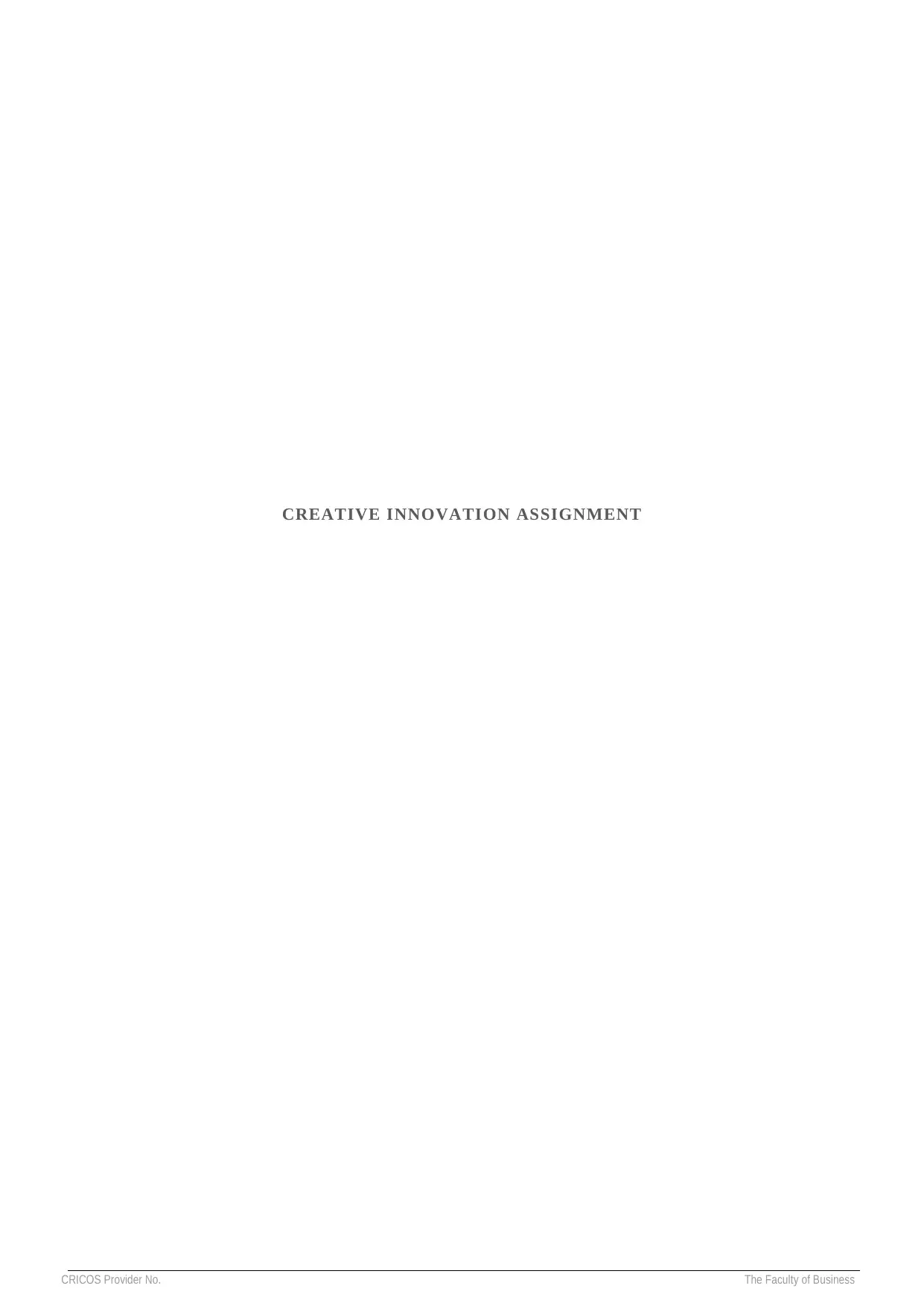
CREATIVE INNOVATION ASSIGNMENT
CRICOS Provider No. The Faculty of Business
CRICOS Provider No. The Faculty of Business
Paraphrase This Document
Need a fresh take? Get an instant paraphrase of this document with our AI Paraphraser
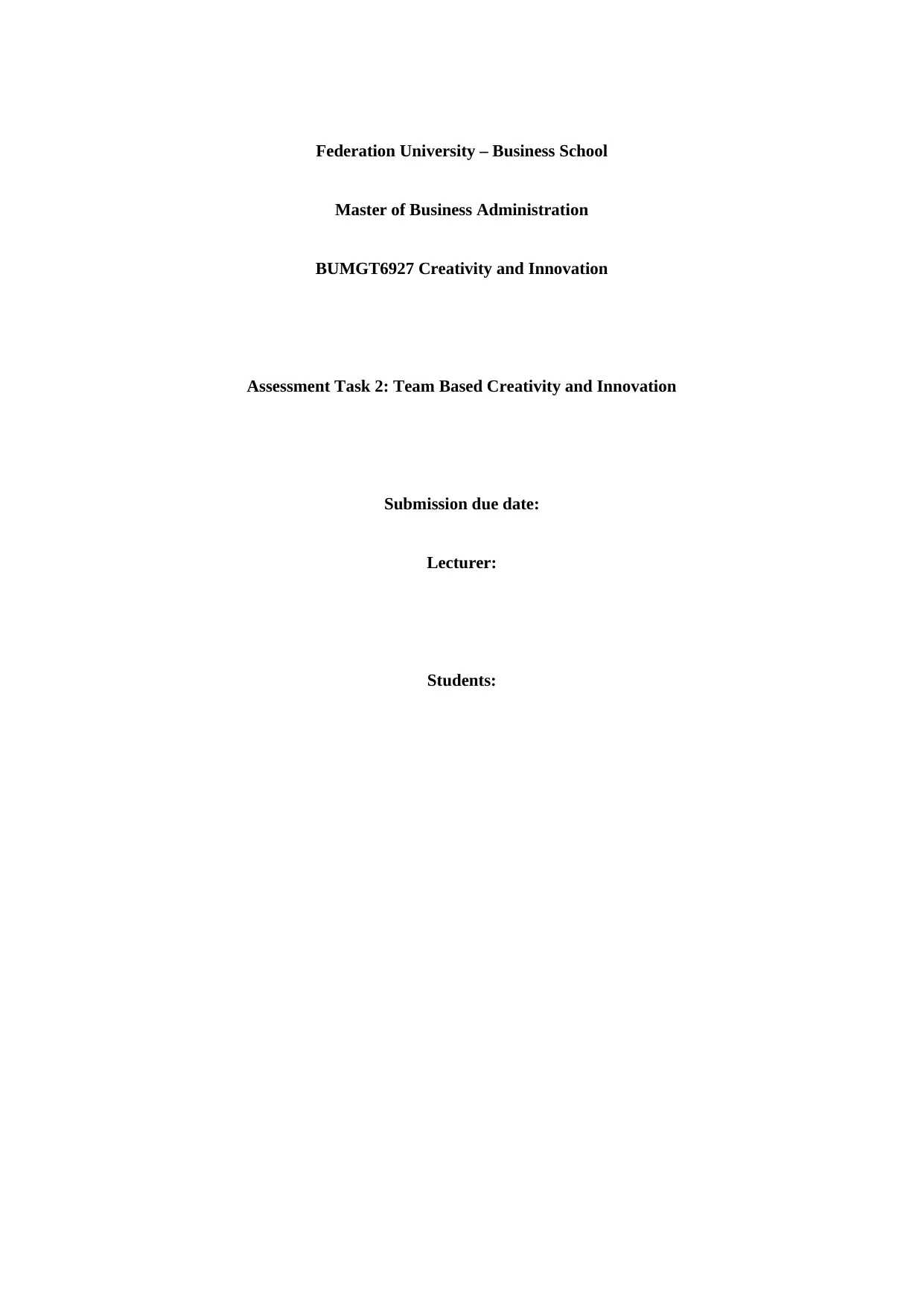
Federation University – Business School
Master of Business Administration
BUMGT6927 Creativity and Innovation
Assessment Task 2: Team Based Creativity and Innovation
Submission due date:
Lecturer:
Students:
Master of Business Administration
BUMGT6927 Creativity and Innovation
Assessment Task 2: Team Based Creativity and Innovation
Submission due date:
Lecturer:
Students:
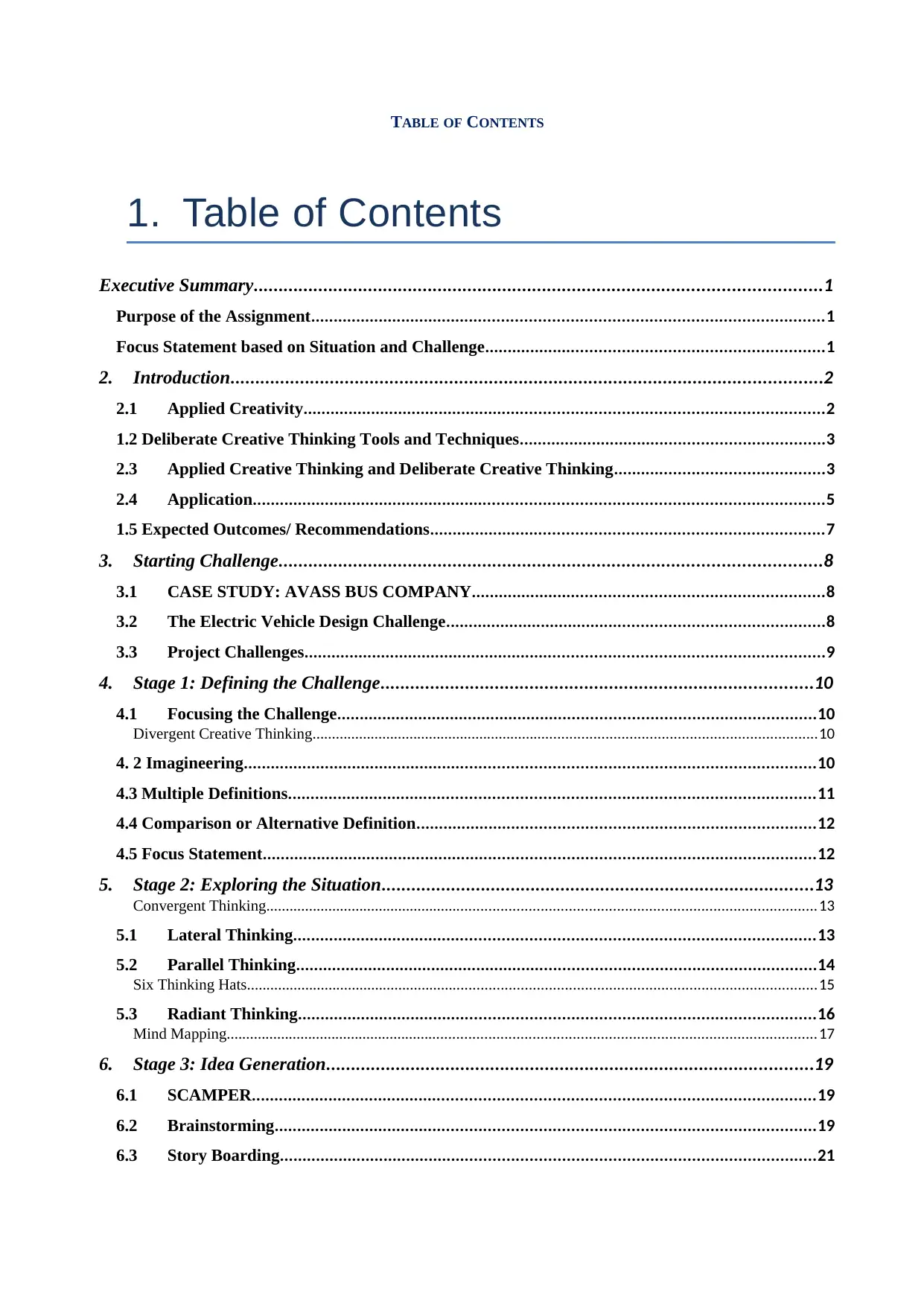
TABLE OF CONTENTS
1. Table of Contents
Executive Summary..................................................................................................................1
Purpose of the Assignment................................................................................................................1
Focus Statement based on Situation and Challenge..........................................................................1
2. Introduction.......................................................................................................................2
2.1 Applied Creativity..................................................................................................................2
1.2 Deliberate Creative Thinking Tools and Techniques...................................................................3
2.3 Applied Creative Thinking and Deliberate Creative Thinking..............................................3
2.4 Application.............................................................................................................................5
1.5 Expected Outcomes/ Recommendations......................................................................................7
3. Starting Challenge.............................................................................................................8
3.1 CASE STUDY: AVASS BUS COMPANY.............................................................................8
3.2 The Electric Vehicle Design Challenge...................................................................................8
3.3 Project Challenges..................................................................................................................9
4. Stage 1: Defining the Challenge.......................................................................................10
4.1 Focusing the Challenge.........................................................................................................10
Divergent Creative Thinking................................................................................................................................10
4. 2 Imagineering.............................................................................................................................10
4.3 Multiple Definitions...................................................................................................................11
4.4 Comparison or Alternative Definition.......................................................................................12
4.5 Focus Statement.........................................................................................................................12
5. Stage 2: Exploring the Situation.......................................................................................13
Convergent Thinking...........................................................................................................................................13
5.1 Lateral Thinking..................................................................................................................13
5.2 Parallel Thinking..................................................................................................................14
Six Thinking Hats................................................................................................................................................15
5.3 Radiant Thinking.................................................................................................................16
Mind Mapping..................................................................................................................................................... 17
6. Stage 3: Idea Generation..................................................................................................19
6.1 SCAMPER...........................................................................................................................19
6.2 Brainstorming......................................................................................................................19
6.3 Story Boarding.....................................................................................................................21
1. Table of Contents
Executive Summary..................................................................................................................1
Purpose of the Assignment................................................................................................................1
Focus Statement based on Situation and Challenge..........................................................................1
2. Introduction.......................................................................................................................2
2.1 Applied Creativity..................................................................................................................2
1.2 Deliberate Creative Thinking Tools and Techniques...................................................................3
2.3 Applied Creative Thinking and Deliberate Creative Thinking..............................................3
2.4 Application.............................................................................................................................5
1.5 Expected Outcomes/ Recommendations......................................................................................7
3. Starting Challenge.............................................................................................................8
3.1 CASE STUDY: AVASS BUS COMPANY.............................................................................8
3.2 The Electric Vehicle Design Challenge...................................................................................8
3.3 Project Challenges..................................................................................................................9
4. Stage 1: Defining the Challenge.......................................................................................10
4.1 Focusing the Challenge.........................................................................................................10
Divergent Creative Thinking................................................................................................................................10
4. 2 Imagineering.............................................................................................................................10
4.3 Multiple Definitions...................................................................................................................11
4.4 Comparison or Alternative Definition.......................................................................................12
4.5 Focus Statement.........................................................................................................................12
5. Stage 2: Exploring the Situation.......................................................................................13
Convergent Thinking...........................................................................................................................................13
5.1 Lateral Thinking..................................................................................................................13
5.2 Parallel Thinking..................................................................................................................14
Six Thinking Hats................................................................................................................................................15
5.3 Radiant Thinking.................................................................................................................16
Mind Mapping..................................................................................................................................................... 17
6. Stage 3: Idea Generation..................................................................................................19
6.1 SCAMPER...........................................................................................................................19
6.2 Brainstorming......................................................................................................................19
6.3 Story Boarding.....................................................................................................................21
⊘ This is a preview!⊘
Do you want full access?
Subscribe today to unlock all pages.

Trusted by 1+ million students worldwide
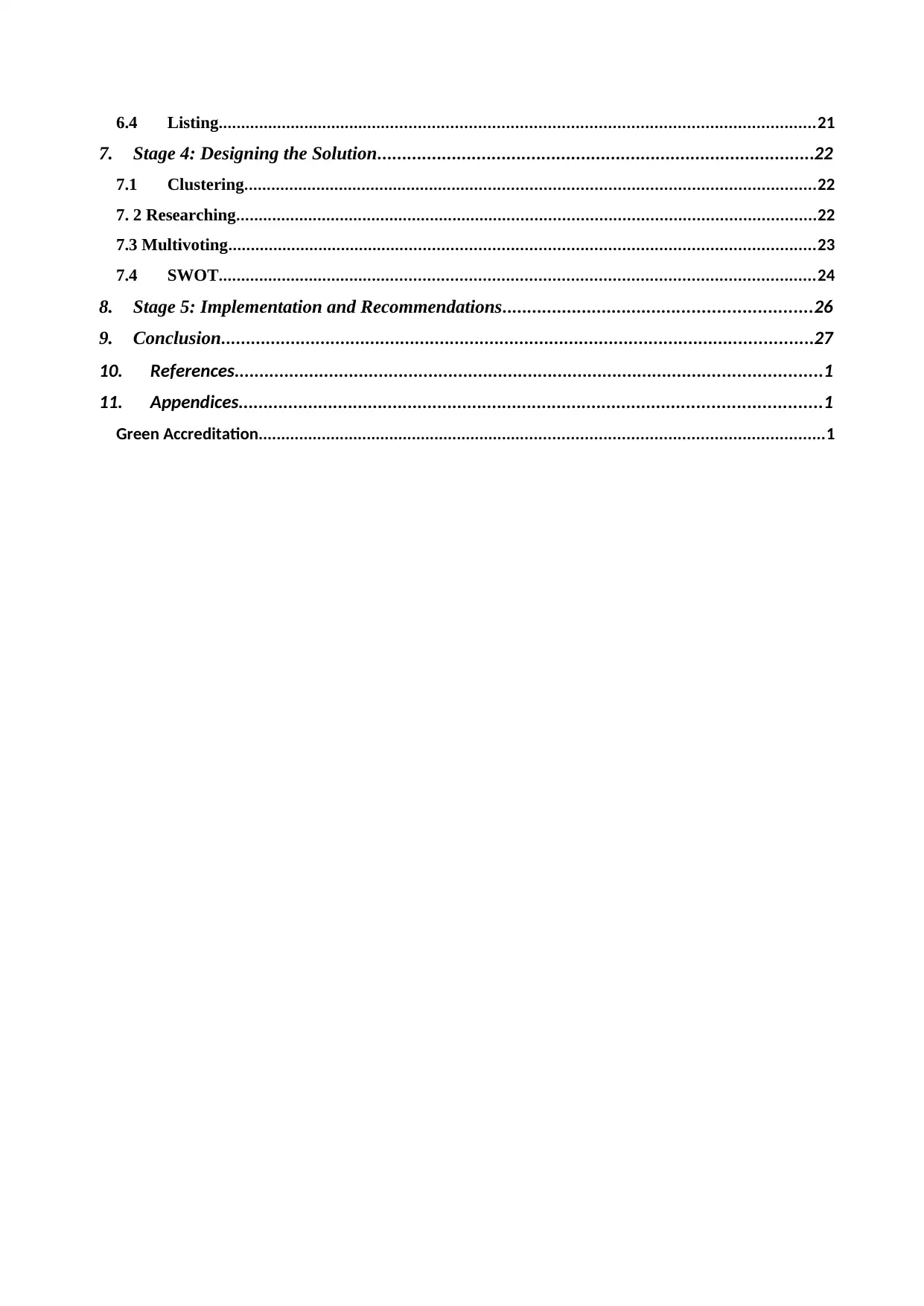
6.4 Listing..................................................................................................................................21
7. Stage 4: Designing the Solution........................................................................................22
7.1 Clustering.............................................................................................................................22
7. 2 Researching...............................................................................................................................22
7.3 Multivoting................................................................................................................................23
7.4 SWOT..................................................................................................................................24
8. Stage 5: Implementation and Recommendations..............................................................26
9. Conclusion.......................................................................................................................27
10. References......................................................................................................................1
11. Appendices.....................................................................................................................1
Green Accreditation............................................................................................................................1
7. Stage 4: Designing the Solution........................................................................................22
7.1 Clustering.............................................................................................................................22
7. 2 Researching...............................................................................................................................22
7.3 Multivoting................................................................................................................................23
7.4 SWOT..................................................................................................................................24
8. Stage 5: Implementation and Recommendations..............................................................26
9. Conclusion.......................................................................................................................27
10. References......................................................................................................................1
11. Appendices.....................................................................................................................1
Green Accreditation............................................................................................................................1
Paraphrase This Document
Need a fresh take? Get an instant paraphrase of this document with our AI Paraphraser
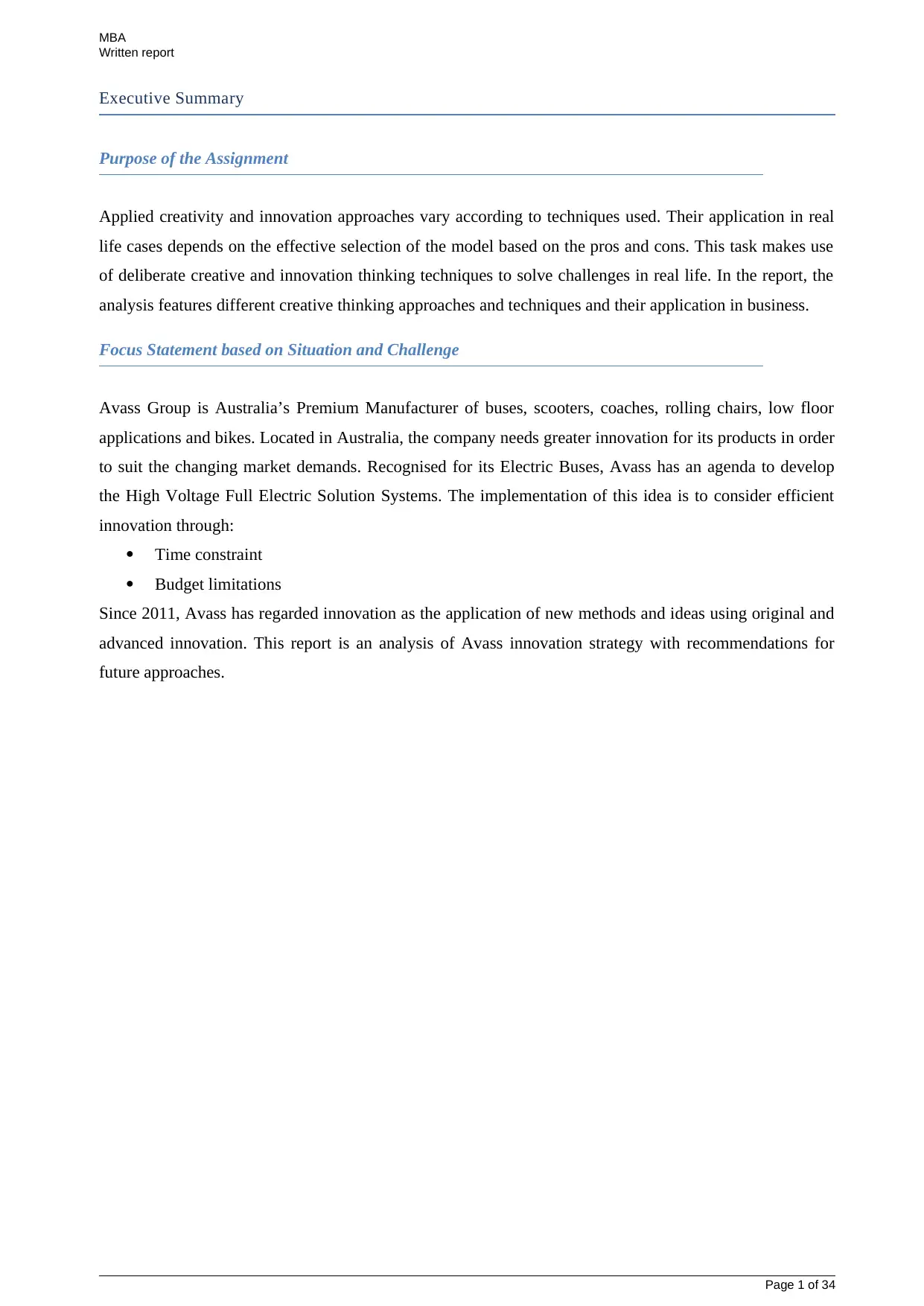
MBA
Written report
Executive Summary
Purpose of the Assignment
Applied creativity and innovation approaches vary according to techniques used. Their application in real
life cases depends on the effective selection of the model based on the pros and cons. This task makes use
of deliberate creative and innovation thinking techniques to solve challenges in real life. In the report, the
analysis features different creative thinking approaches and techniques and their application in business.
Focus Statement based on Situation and Challenge
Avass Group is Australia’s Premium Manufacturer of buses, scooters, coaches, rolling chairs, low floor
applications and bikes. Located in Australia, the company needs greater innovation for its products in order
to suit the changing market demands. Recognised for its Electric Buses, Avass has an agenda to develop
the High Voltage Full Electric Solution Systems. The implementation of this idea is to consider efficient
innovation through:
Time constraint
Budget limitations
Since 2011, Avass has regarded innovation as the application of new methods and ideas using original and
advanced innovation. This report is an analysis of Avass innovation strategy with recommendations for
future approaches.
Page 1 of 34
Written report
Executive Summary
Purpose of the Assignment
Applied creativity and innovation approaches vary according to techniques used. Their application in real
life cases depends on the effective selection of the model based on the pros and cons. This task makes use
of deliberate creative and innovation thinking techniques to solve challenges in real life. In the report, the
analysis features different creative thinking approaches and techniques and their application in business.
Focus Statement based on Situation and Challenge
Avass Group is Australia’s Premium Manufacturer of buses, scooters, coaches, rolling chairs, low floor
applications and bikes. Located in Australia, the company needs greater innovation for its products in order
to suit the changing market demands. Recognised for its Electric Buses, Avass has an agenda to develop
the High Voltage Full Electric Solution Systems. The implementation of this idea is to consider efficient
innovation through:
Time constraint
Budget limitations
Since 2011, Avass has regarded innovation as the application of new methods and ideas using original and
advanced innovation. This report is an analysis of Avass innovation strategy with recommendations for
future approaches.
Page 1 of 34
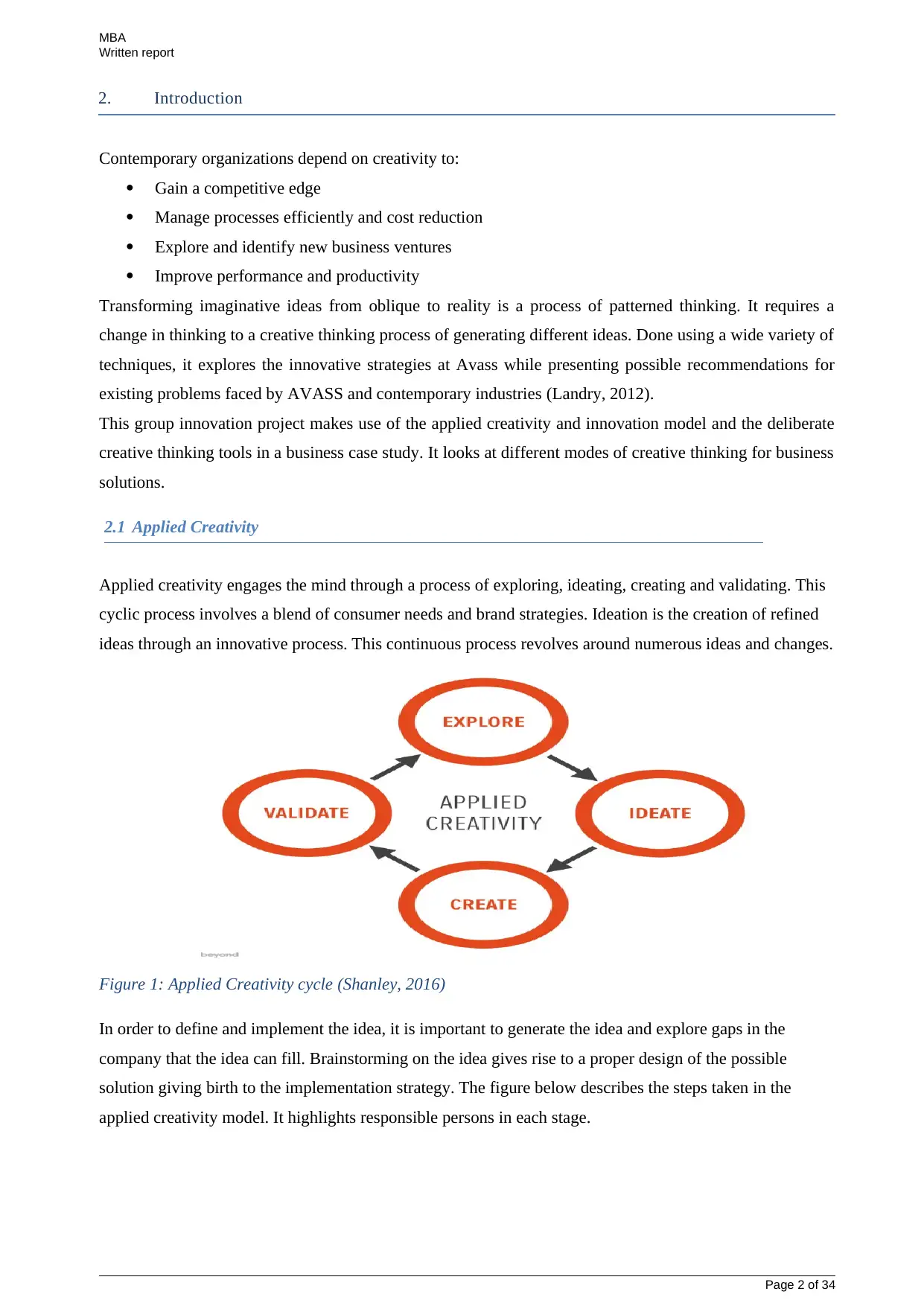
MBA
Written report
2. Introduction
Contemporary organizations depend on creativity to:
Gain a competitive edge
Manage processes efficiently and cost reduction
Explore and identify new business ventures
Improve performance and productivity
Transforming imaginative ideas from oblique to reality is a process of patterned thinking. It requires a
change in thinking to a creative thinking process of generating different ideas. Done using a wide variety of
techniques, it explores the innovative strategies at Avass while presenting possible recommendations for
existing problems faced by AVASS and contemporary industries (Landry, 2012).
This group innovation project makes use of the applied creativity and innovation model and the deliberate
creative thinking tools in a business case study. It looks at different modes of creative thinking for business
solutions.
2.1 Applied Creativity
Applied creativity engages the mind through a process of exploring, ideating, creating and validating. This
cyclic process involves a blend of consumer needs and brand strategies. Ideation is the creation of refined
ideas through an innovative process. This continuous process revolves around numerous ideas and changes.
Figure 1: Applied Creativity cycle (Shanley, 2016)
In order to define and implement the idea, it is important to generate the idea and explore gaps in the
company that the idea can fill. Brainstorming on the idea gives rise to a proper design of the possible
solution giving birth to the implementation strategy. The figure below describes the steps taken in the
applied creativity model. It highlights responsible persons in each stage.
Page 2 of 34
Written report
2. Introduction
Contemporary organizations depend on creativity to:
Gain a competitive edge
Manage processes efficiently and cost reduction
Explore and identify new business ventures
Improve performance and productivity
Transforming imaginative ideas from oblique to reality is a process of patterned thinking. It requires a
change in thinking to a creative thinking process of generating different ideas. Done using a wide variety of
techniques, it explores the innovative strategies at Avass while presenting possible recommendations for
existing problems faced by AVASS and contemporary industries (Landry, 2012).
This group innovation project makes use of the applied creativity and innovation model and the deliberate
creative thinking tools in a business case study. It looks at different modes of creative thinking for business
solutions.
2.1 Applied Creativity
Applied creativity engages the mind through a process of exploring, ideating, creating and validating. This
cyclic process involves a blend of consumer needs and brand strategies. Ideation is the creation of refined
ideas through an innovative process. This continuous process revolves around numerous ideas and changes.
Figure 1: Applied Creativity cycle (Shanley, 2016)
In order to define and implement the idea, it is important to generate the idea and explore gaps in the
company that the idea can fill. Brainstorming on the idea gives rise to a proper design of the possible
solution giving birth to the implementation strategy. The figure below describes the steps taken in the
applied creativity model. It highlights responsible persons in each stage.
Page 2 of 34
⊘ This is a preview!⊘
Do you want full access?
Subscribe today to unlock all pages.

Trusted by 1+ million students worldwide
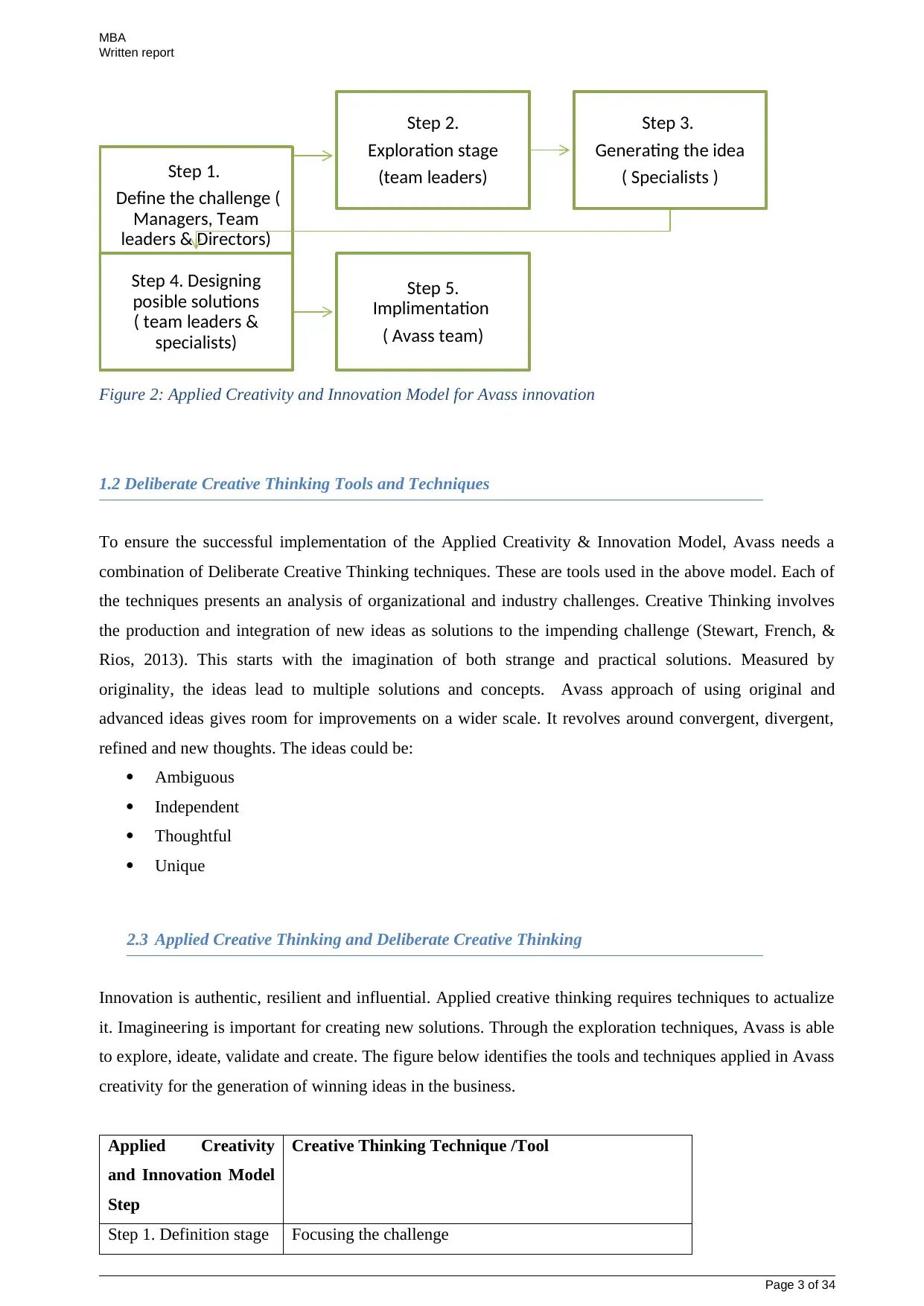
MBA
Written report
Figure 2: Applied Creativity and Innovation Model for Avass innovation
1.2 Deliberate Creative Thinking Tools and Techniques
To ensure the successful implementation of the Applied Creativity & Innovation Model, Avass needs a
combination of Deliberate Creative Thinking techniques. These are tools used in the above model. Each of
the techniques presents an analysis of organizational and industry challenges. Creative Thinking involves
the production and integration of new ideas as solutions to the impending challenge (Stewart, French, &
Rios, 2013). This starts with the imagination of both strange and practical solutions. Measured by
originality, the ideas lead to multiple solutions and concepts. Avass approach of using original and
advanced ideas gives room for improvements on a wider scale. It revolves around convergent, divergent,
refined and new thoughts. The ideas could be:
Ambiguous
Independent
Thoughtful
Unique
2.3 Applied Creative Thinking and Deliberate Creative Thinking
Innovation is authentic, resilient and influential. Applied creative thinking requires techniques to actualize
it. Imagineering is important for creating new solutions. Through the exploration techniques, Avass is able
to explore, ideate, validate and create. The figure below identifies the tools and techniques applied in Avass
creativity for the generation of winning ideas in the business.
Applied Creativity
and Innovation Model
Step
Creative Thinking Technique /Tool
Step 1. Definition stage Focusing the challenge
Page 3 of 34
Step 1.
Define the challenge (
Managers, Team
leaders & Directors)
Step 2.
Exploration stage
(team leaders)
Step 3.
Generating the idea
( Specialists )
Step 4. Designing
posible solutions
( team leaders &
specialists)
Step 5.
Implimentation
( Avass team)
Written report
Figure 2: Applied Creativity and Innovation Model for Avass innovation
1.2 Deliberate Creative Thinking Tools and Techniques
To ensure the successful implementation of the Applied Creativity & Innovation Model, Avass needs a
combination of Deliberate Creative Thinking techniques. These are tools used in the above model. Each of
the techniques presents an analysis of organizational and industry challenges. Creative Thinking involves
the production and integration of new ideas as solutions to the impending challenge (Stewart, French, &
Rios, 2013). This starts with the imagination of both strange and practical solutions. Measured by
originality, the ideas lead to multiple solutions and concepts. Avass approach of using original and
advanced ideas gives room for improvements on a wider scale. It revolves around convergent, divergent,
refined and new thoughts. The ideas could be:
Ambiguous
Independent
Thoughtful
Unique
2.3 Applied Creative Thinking and Deliberate Creative Thinking
Innovation is authentic, resilient and influential. Applied creative thinking requires techniques to actualize
it. Imagineering is important for creating new solutions. Through the exploration techniques, Avass is able
to explore, ideate, validate and create. The figure below identifies the tools and techniques applied in Avass
creativity for the generation of winning ideas in the business.
Applied Creativity
and Innovation Model
Step
Creative Thinking Technique /Tool
Step 1. Definition stage Focusing the challenge
Page 3 of 34
Step 1.
Define the challenge (
Managers, Team
leaders & Directors)
Step 2.
Exploration stage
(team leaders)
Step 3.
Generating the idea
( Specialists )
Step 4. Designing
posible solutions
( team leaders &
specialists)
Step 5.
Implimentation
( Avass team)
Paraphrase This Document
Need a fresh take? Get an instant paraphrase of this document with our AI Paraphraser
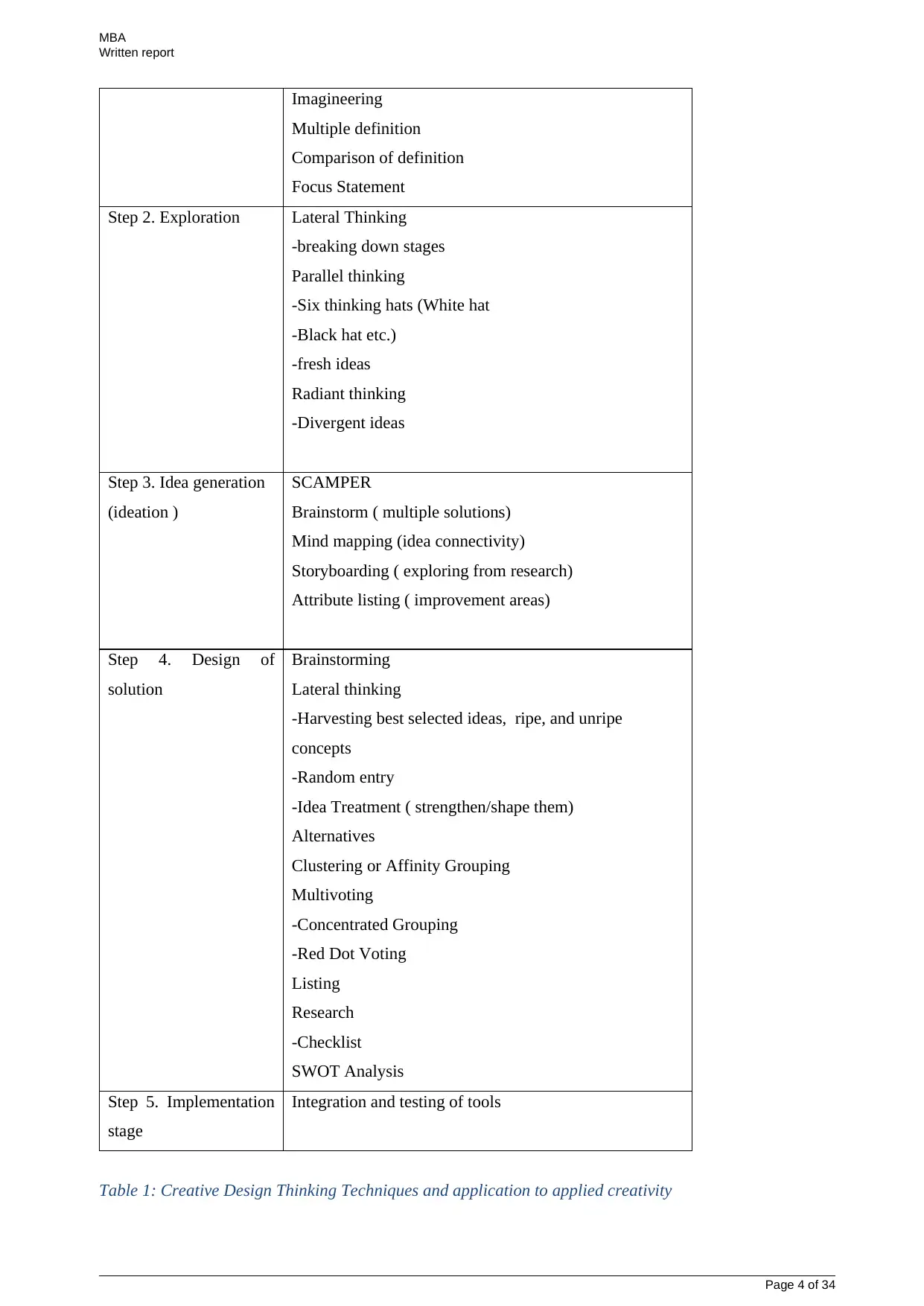
MBA
Written report
Imagineering
Multiple definition
Comparison of definition
Focus Statement
Step 2. Exploration Lateral Thinking
-breaking down stages
Parallel thinking
-Six thinking hats (White hat
-Black hat etc.)
-fresh ideas
Radiant thinking
-Divergent ideas
Step 3. Idea generation
(ideation )
SCAMPER
Brainstorm ( multiple solutions)
Mind mapping (idea connectivity)
Storyboarding ( exploring from research)
Attribute listing ( improvement areas)
Step 4. Design of
solution
Brainstorming
Lateral thinking
-Harvesting best selected ideas, ripe, and unripe
concepts
-Random entry
-Idea Treatment ( strengthen/shape them)
Alternatives
Clustering or Affinity Grouping
Multivoting
-Concentrated Grouping
-Red Dot Voting
Listing
Research
-Checklist
SWOT Analysis
Step 5. Implementation
stage
Integration and testing of tools
Table 1: Creative Design Thinking Techniques and application to applied creativity
Page 4 of 34
Written report
Imagineering
Multiple definition
Comparison of definition
Focus Statement
Step 2. Exploration Lateral Thinking
-breaking down stages
Parallel thinking
-Six thinking hats (White hat
-Black hat etc.)
-fresh ideas
Radiant thinking
-Divergent ideas
Step 3. Idea generation
(ideation )
SCAMPER
Brainstorm ( multiple solutions)
Mind mapping (idea connectivity)
Storyboarding ( exploring from research)
Attribute listing ( improvement areas)
Step 4. Design of
solution
Brainstorming
Lateral thinking
-Harvesting best selected ideas, ripe, and unripe
concepts
-Random entry
-Idea Treatment ( strengthen/shape them)
Alternatives
Clustering or Affinity Grouping
Multivoting
-Concentrated Grouping
-Red Dot Voting
Listing
Research
-Checklist
SWOT Analysis
Step 5. Implementation
stage
Integration and testing of tools
Table 1: Creative Design Thinking Techniques and application to applied creativity
Page 4 of 34
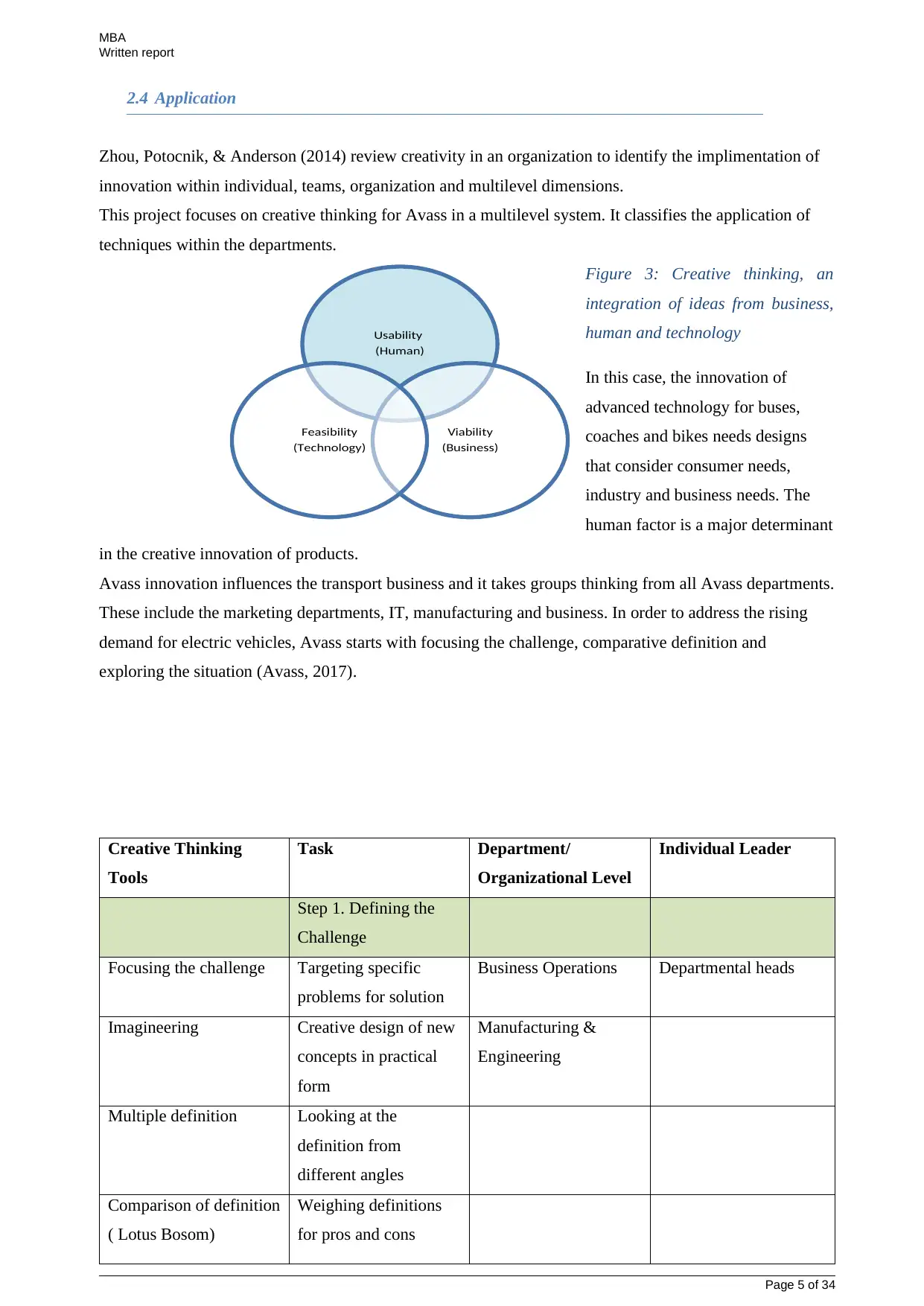
MBA
Written report
2.4 Application
Zhou, Potocnik, & Anderson (2014) review creativity in an organization to identify the implimentation of
innovation within individual, teams, organization and multilevel dimensions.
This project focuses on creative thinking for Avass in a multilevel system. It classifies the application of
techniques within the departments.
Figure 3: Creative thinking, an
integration of ideas from business,
human and technology
In this case, the innovation of
advanced technology for buses,
coaches and bikes needs designs
that consider consumer needs,
industry and business needs. The
human factor is a major determinant
in the creative innovation of products.
Avass innovation influences the transport business and it takes groups thinking from all Avass departments.
These include the marketing departments, IT, manufacturing and business. In order to address the rising
demand for electric vehicles, Avass starts with focusing the challenge, comparative definition and
exploring the situation (Avass, 2017).
Creative Thinking
Tools
Task Department/
Organizational Level
Individual Leader
Step 1. Defining the
Challenge
Focusing the challenge Targeting specific
problems for solution
Business Operations Departmental heads
Imagineering Creative design of new
concepts in practical
form
Manufacturing &
Engineering
Multiple definition Looking at the
definition from
different angles
Comparison of definition
( Lotus Bosom)
Weighing definitions
for pros and cons
Page 5 of 34
Usability
(Human)
Viability
(Business)
Feasibility
(Technology)
Written report
2.4 Application
Zhou, Potocnik, & Anderson (2014) review creativity in an organization to identify the implimentation of
innovation within individual, teams, organization and multilevel dimensions.
This project focuses on creative thinking for Avass in a multilevel system. It classifies the application of
techniques within the departments.
Figure 3: Creative thinking, an
integration of ideas from business,
human and technology
In this case, the innovation of
advanced technology for buses,
coaches and bikes needs designs
that consider consumer needs,
industry and business needs. The
human factor is a major determinant
in the creative innovation of products.
Avass innovation influences the transport business and it takes groups thinking from all Avass departments.
These include the marketing departments, IT, manufacturing and business. In order to address the rising
demand for electric vehicles, Avass starts with focusing the challenge, comparative definition and
exploring the situation (Avass, 2017).
Creative Thinking
Tools
Task Department/
Organizational Level
Individual Leader
Step 1. Defining the
Challenge
Focusing the challenge Targeting specific
problems for solution
Business Operations Departmental heads
Imagineering Creative design of new
concepts in practical
form
Manufacturing &
Engineering
Multiple definition Looking at the
definition from
different angles
Comparison of definition
( Lotus Bosom)
Weighing definitions
for pros and cons
Page 5 of 34
Usability
(Human)
Viability
(Business)
Feasibility
(Technology)
⊘ This is a preview!⊘
Do you want full access?
Subscribe today to unlock all pages.

Trusted by 1+ million students worldwide
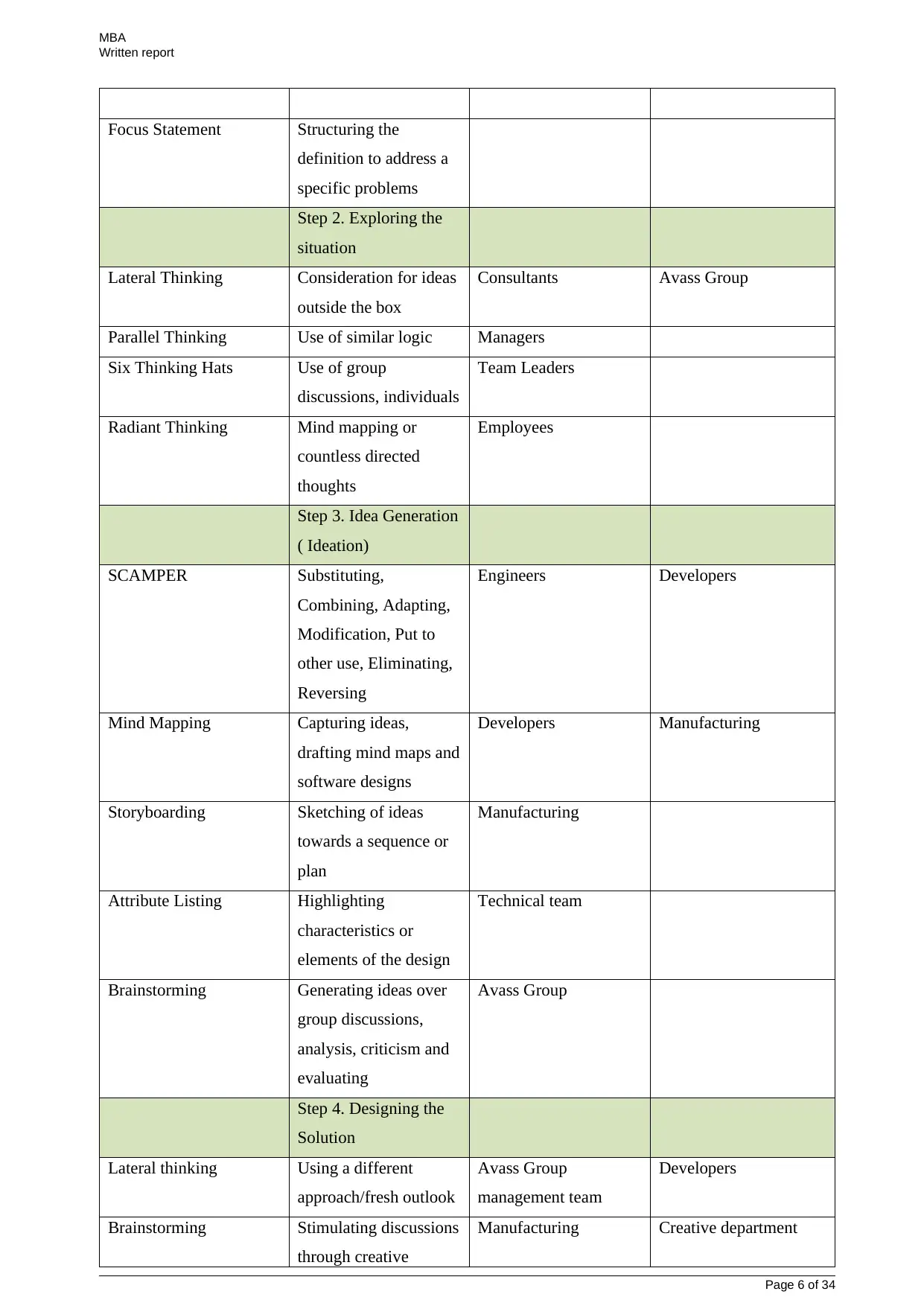
MBA
Written report
Focus Statement Structuring the
definition to address a
specific problems
Step 2. Exploring the
situation
Lateral Thinking Consideration for ideas
outside the box
Consultants Avass Group
Parallel Thinking Use of similar logic Managers
Six Thinking Hats Use of group
discussions, individuals
Team Leaders
Radiant Thinking Mind mapping or
countless directed
thoughts
Employees
Step 3. Idea Generation
( Ideation)
SCAMPER Substituting,
Combining, Adapting,
Modification, Put to
other use, Eliminating,
Reversing
Engineers Developers
Mind Mapping Capturing ideas,
drafting mind maps and
software designs
Developers Manufacturing
Storyboarding Sketching of ideas
towards a sequence or
plan
Manufacturing
Attribute Listing Highlighting
characteristics or
elements of the design
Technical team
Brainstorming Generating ideas over
group discussions,
analysis, criticism and
evaluating
Avass Group
Step 4. Designing the
Solution
Lateral thinking Using a different
approach/fresh outlook
Avass Group
management team
Developers
Brainstorming Stimulating discussions
through creative
Manufacturing Creative department
Page 6 of 34
Written report
Focus Statement Structuring the
definition to address a
specific problems
Step 2. Exploring the
situation
Lateral Thinking Consideration for ideas
outside the box
Consultants Avass Group
Parallel Thinking Use of similar logic Managers
Six Thinking Hats Use of group
discussions, individuals
Team Leaders
Radiant Thinking Mind mapping or
countless directed
thoughts
Employees
Step 3. Idea Generation
( Ideation)
SCAMPER Substituting,
Combining, Adapting,
Modification, Put to
other use, Eliminating,
Reversing
Engineers Developers
Mind Mapping Capturing ideas,
drafting mind maps and
software designs
Developers Manufacturing
Storyboarding Sketching of ideas
towards a sequence or
plan
Manufacturing
Attribute Listing Highlighting
characteristics or
elements of the design
Technical team
Brainstorming Generating ideas over
group discussions,
analysis, criticism and
evaluating
Avass Group
Step 4. Designing the
Solution
Lateral thinking Using a different
approach/fresh outlook
Avass Group
management team
Developers
Brainstorming Stimulating discussions
through creative
Manufacturing Creative department
Page 6 of 34
Paraphrase This Document
Need a fresh take? Get an instant paraphrase of this document with our AI Paraphraser
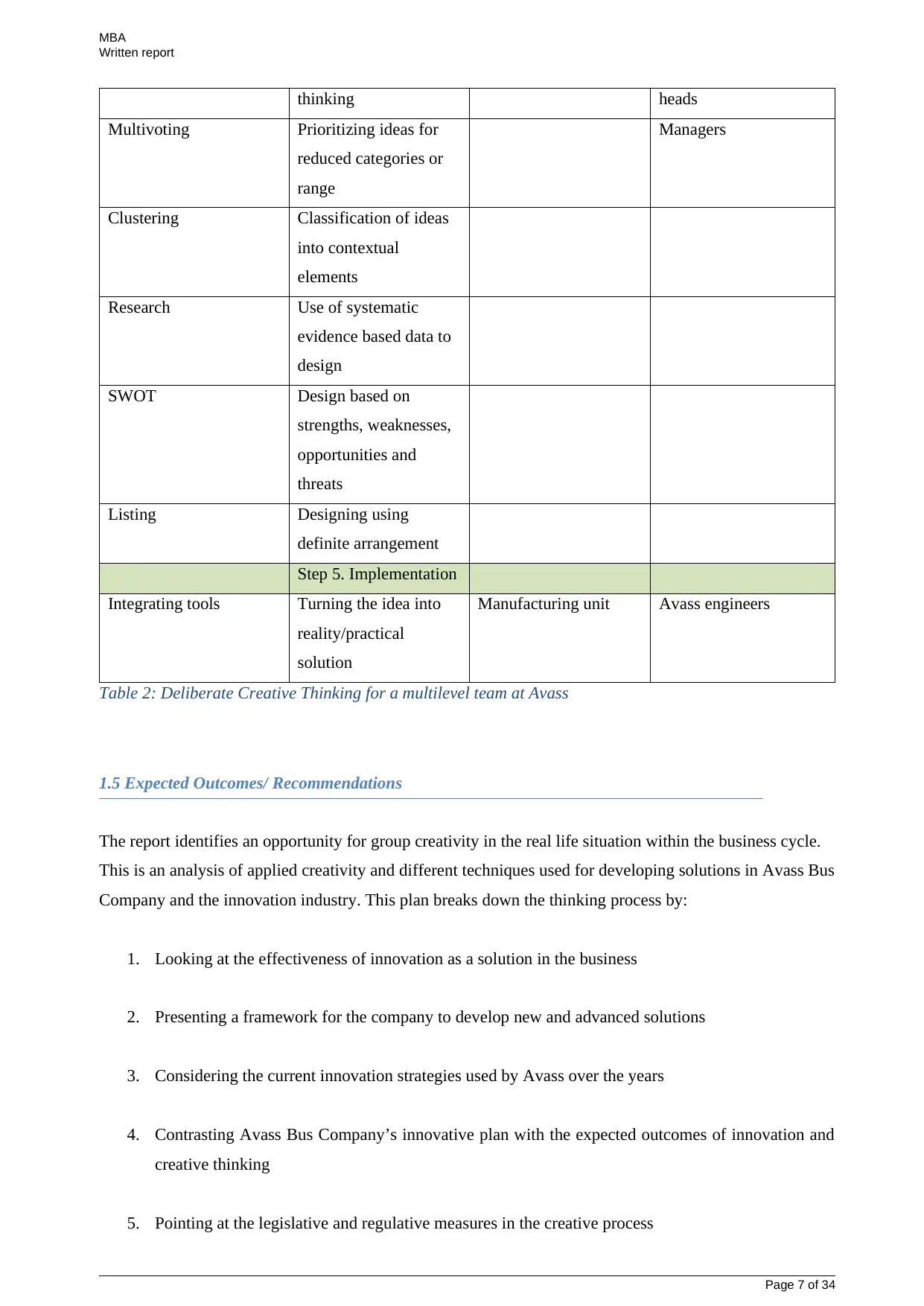
MBA
Written report
thinking heads
Multivoting Prioritizing ideas for
reduced categories or
range
Managers
Clustering Classification of ideas
into contextual
elements
Research Use of systematic
evidence based data to
design
SWOT Design based on
strengths, weaknesses,
opportunities and
threats
Listing Designing using
definite arrangement
Step 5. Implementation
Integrating tools Turning the idea into
reality/practical
solution
Manufacturing unit Avass engineers
Table 2: Deliberate Creative Thinking for a multilevel team at Avass
1.5 Expected Outcomes/ Recommendations
The report identifies an opportunity for group creativity in the real life situation within the business cycle.
This is an analysis of applied creativity and different techniques used for developing solutions in Avass Bus
Company and the innovation industry. This plan breaks down the thinking process by:
1. Looking at the effectiveness of innovation as a solution in the business
2. Presenting a framework for the company to develop new and advanced solutions
3. Considering the current innovation strategies used by Avass over the years
4. Contrasting Avass Bus Company’s innovative plan with the expected outcomes of innovation and
creative thinking
5. Pointing at the legislative and regulative measures in the creative process
Page 7 of 34
Written report
thinking heads
Multivoting Prioritizing ideas for
reduced categories or
range
Managers
Clustering Classification of ideas
into contextual
elements
Research Use of systematic
evidence based data to
design
SWOT Design based on
strengths, weaknesses,
opportunities and
threats
Listing Designing using
definite arrangement
Step 5. Implementation
Integrating tools Turning the idea into
reality/practical
solution
Manufacturing unit Avass engineers
Table 2: Deliberate Creative Thinking for a multilevel team at Avass
1.5 Expected Outcomes/ Recommendations
The report identifies an opportunity for group creativity in the real life situation within the business cycle.
This is an analysis of applied creativity and different techniques used for developing solutions in Avass Bus
Company and the innovation industry. This plan breaks down the thinking process by:
1. Looking at the effectiveness of innovation as a solution in the business
2. Presenting a framework for the company to develop new and advanced solutions
3. Considering the current innovation strategies used by Avass over the years
4. Contrasting Avass Bus Company’s innovative plan with the expected outcomes of innovation and
creative thinking
5. Pointing at the legislative and regulative measures in the creative process
Page 7 of 34
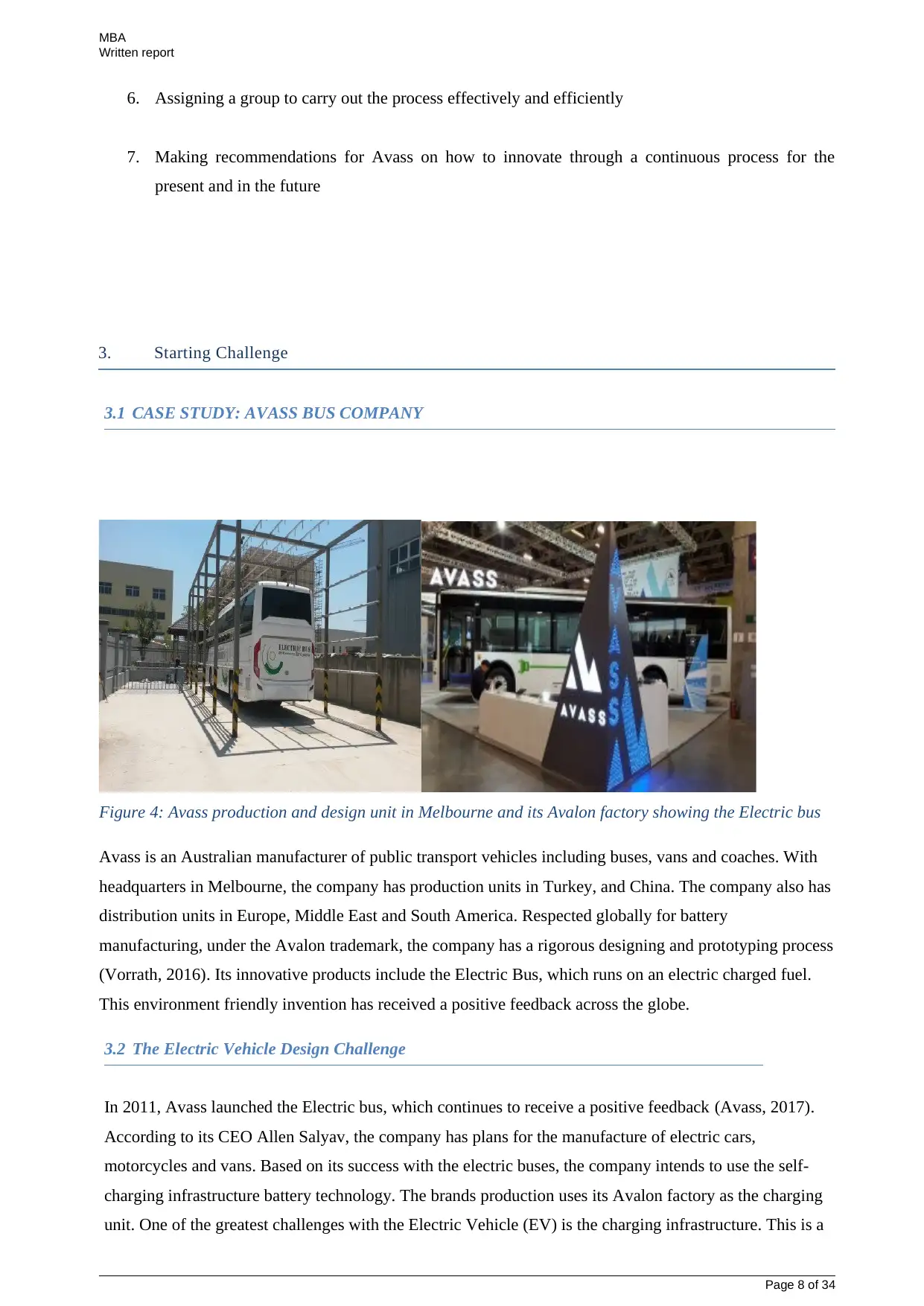
MBA
Written report
6. Assigning a group to carry out the process effectively and efficiently
7. Making recommendations for Avass on how to innovate through a continuous process for the
present and in the future
3. Starting Challenge
3.1 CASE STUDY: AVASS BUS COMPANY
Figure 4: Avass production and design unit in Melbourne and its Avalon factory showing the Electric bus
Avass is an Australian manufacturer of public transport vehicles including buses, vans and coaches. With
headquarters in Melbourne, the company has production units in Turkey, and China. The company also has
distribution units in Europe, Middle East and South America. Respected globally for battery
manufacturing, under the Avalon trademark, the company has a rigorous designing and prototyping process
(Vorrath, 2016). Its innovative products include the Electric Bus, which runs on an electric charged fuel.
This environment friendly invention has received a positive feedback across the globe.
3.2 The Electric Vehicle Design Challenge
In 2011, Avass launched the Electric bus, which continues to receive a positive feedback (Avass, 2017).
According to its CEO Allen Salyav, the company has plans for the manufacture of electric cars,
motorcycles and vans. Based on its success with the electric buses, the company intends to use the self-
charging infrastructure battery technology. The brands production uses its Avalon factory as the charging
unit. One of the greatest challenges with the Electric Vehicle (EV) is the charging infrastructure. This is a
Page 8 of 34
Written report
6. Assigning a group to carry out the process effectively and efficiently
7. Making recommendations for Avass on how to innovate through a continuous process for the
present and in the future
3. Starting Challenge
3.1 CASE STUDY: AVASS BUS COMPANY
Figure 4: Avass production and design unit in Melbourne and its Avalon factory showing the Electric bus
Avass is an Australian manufacturer of public transport vehicles including buses, vans and coaches. With
headquarters in Melbourne, the company has production units in Turkey, and China. The company also has
distribution units in Europe, Middle East and South America. Respected globally for battery
manufacturing, under the Avalon trademark, the company has a rigorous designing and prototyping process
(Vorrath, 2016). Its innovative products include the Electric Bus, which runs on an electric charged fuel.
This environment friendly invention has received a positive feedback across the globe.
3.2 The Electric Vehicle Design Challenge
In 2011, Avass launched the Electric bus, which continues to receive a positive feedback (Avass, 2017).
According to its CEO Allen Salyav, the company has plans for the manufacture of electric cars,
motorcycles and vans. Based on its success with the electric buses, the company intends to use the self-
charging infrastructure battery technology. The brands production uses its Avalon factory as the charging
unit. One of the greatest challenges with the Electric Vehicle (EV) is the charging infrastructure. This is a
Page 8 of 34
⊘ This is a preview!⊘
Do you want full access?
Subscribe today to unlock all pages.

Trusted by 1+ million students worldwide
1 out of 34
Related Documents
Your All-in-One AI-Powered Toolkit for Academic Success.
+13062052269
info@desklib.com
Available 24*7 on WhatsApp / Email
![[object Object]](/_next/static/media/star-bottom.7253800d.svg)
Unlock your academic potential
Copyright © 2020–2025 A2Z Services. All Rights Reserved. Developed and managed by ZUCOL.





